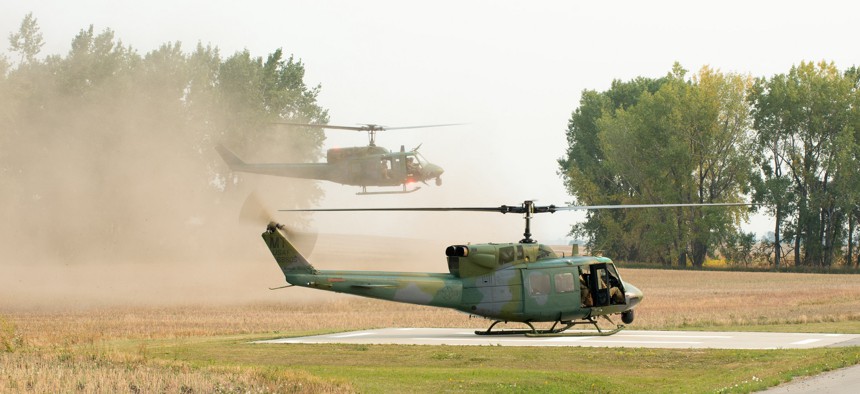
Defense Secretary Jim Mattis arrives at a missile alert facility in North Dakota on Sept. 13, 2017. Staff Sgt. Jette Carr/Air Force
At U.S. Nuclear Weapons Base, Mattis Signals Support for Triad
But the Defense chief stopped short of endorsing all types of new nuclear weapons in development.
MINOT AIR FORCE BASE, N.D. — U.S. Defense Secretary Jim Mattis signaled his support for all three legs of the venerable nuclear triad, but stopped short of endorsing all of the new weapon projects in the works.
His visit to this base — home to B-52 bombers and one-third of America’s intercontinental ballistic missiles — comes as the Pentagon considers many options for replacing nearly every part of its nuclear arsenal, including ICBMs, bombers, and submarines. It also comes as Russia and China improve their nuclear weapons and North Korea builds its own nuclear arsenal.
Those decisions will be made as part of the Pentagon’s nuclear posture review, begun in April.
“I review it every couple of weeks,” Mattis told reporters on a flight from Washington to Minot on Wednesday morning. “It’s on a schedule. It’s meeting the current schedule.”
The defense secretary hinted that the review could wrap up around the end of the year or early next. But he did signal that all three legs of the triad would endure.
“I have questioned the triad and I cannot solve the deterrent problem reducing it from a triad,” said Mattis, who told lawmakers at a 2015 Senate Armed Services Committee hearing that he suspected that ICBMs were no longer necessary. But now, he said, “If I want to send the most compelling message, I have been persuaded that the triad in its framework is the right way to go.”
At Minot, he descended more than 80 feet below ground to visit an ICBM control center behind massive blast-proof doors. He toured a fortified maintenance factory where nuclear warheads are overhauled and repaired, and got a look at a B-52 bomber. Airmen who briefed the secretary said he asked lots of questions.
The price tag for replacing the military’s nuclear weapons could run as high as $1.5 trillion over three decades.
“America can afford survival,” Mattis said when asked how to pay for all of the new weapons. “But you’ve got to have a persuasive argument with the Congress.”
Asked if the money should come from the Pentagon budget or a separate spending account, he said, “This is something we’ll have to go to Congress and see how they want to go forward and the president’s [Office of Management and Budget] people will work with us to propose what we think is the best idea that Congress, and their co-equal status holding the purse strings, will have to determine what’s the best way to go about doing this.”
In recent weeks, the Air Force awarded four massive contracts to start developing new nuclear weapons: half for new ICBMs and half for a controversial cruise missile. Mattis said the cruise missile contract is not an indication the Pentagon would buy the weapon.
“That’s to maintain that weapon as an option,” Mattis said of the two contracts totaling $1.8 billion. “It is not a decision yet.”
He did voice solid support for a planned new ballistic missile submarine to replace the Navy’s Ohio class.
“The maritime part of the triad is the most survivable, so I think that’s the answer, if you see what I mean,” Mattis said. “Absolutely, we’ll maintain it.”
Morale Boost
Numerous Air Force officials at Minot told reporters that their base and mission have received increased attention in recent years. Recent weeks have brought visits from Air Force Secretary Heather Wilson and Gen. Robin Rand, who leads Global Strike Command, the arm of the service that oversees nuclear weapons.
That’s a morale boost for the airmen who oversee, maintain, and guard these deadly weapons. It’s a far better than a decade ago when the service reeled from scandals involving mishandling of weapons, cheating and drug use within the nuclear ranks.
Investing more money in the mission and quality-of-life improvements have improved assignments to Minot — where the wind chill can hit 50 degrees below zero — according to Maj. Neil Carpenter, commander of the 91st Missile Maintenance Squadron, which works on the Minuteman III rockets.
Carpenter said morale has been boosted by leadership’s increased attention to the nuclear mission, and small changes like replacing old pickup trucks with newer, more reliable models.
“You can see and feel the differences,” he said.
Down in the control bunker, 2nd Lt. Tia Hewuse described her mission: training for and standing ready to verify missile launch codes and turn switches that would fire an ICBM. She said she passes much of her 24-hour shifts in the bunker studying for her masters’ degree in entrepreneurship.
Behind her seat are two padlocks, one for each of the two missileers in the control center. They guard the launch codes. Hewuse’s lock was covered in gold glitter.
“There’s no sunshine down here,” she said with a smile. “That’s my sunshine.”







